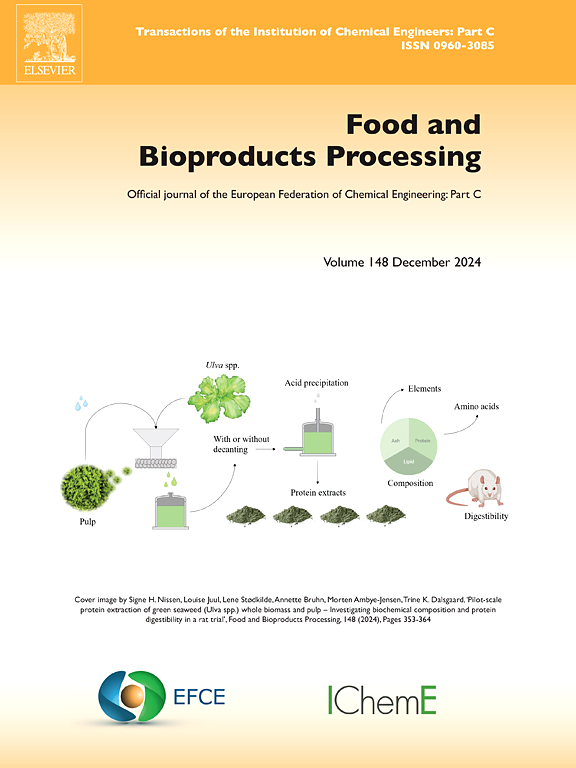Determination of phenolics and proteins causing sediment formation in pomegranate juice using “Tannase+Lactonase” and “Protease”
IF 3.5
2区 农林科学
Q2 BIOTECHNOLOGY & APPLIED MICROBIOLOGY
引用次数: 0
Abstract
In this study, pomegranate juice (PJ) was treated with “tannase+lactonase [human-derived (H-PON-1) or rabbit-derived (R-PON-1)]” or “protease [aspartic protease (AP) or cysteine protease (CP)].” After treatment, effects of tannins, proteins and amino acids on sediment formation were determined during storage at 20℃. Among proteins, prolamin showed the highest effect in PJ treated with “tannase+H-PON-1/R-PON-1” and CP. While amino acids did not affect sediment formation in “tannase+H-PON-1/R-PON-1” or AP treatments, only glycine increased sediment content in CP treatment. Removal of galloyl and/or HHDP groups from HHDP-galloyl-glucose-isomer, pedunculagin-2 and punigluconin by “tannase+H-PON-1/R-PON-1” was very effective in preventing sediment formation. Prolamin:galloyl glucose isomer ratio and HHDP-galloyl-hexoside-2 and HHDP-galloyl-glucuronide contents should be 23.244±1.162 and, 1.254±0.063 and 0.679±0.034 mg/L to prevent sediment, respectively. Since common parameters preventing sediment formation in both methods that target removal of tannins and/or proteins were punigluconin content and prolamin:punicalagin-2 ratio, these two parameters must also be considered in sediment-free PJ production.
使用 "单宁酶+乳酸菌酶 "和 "蛋白酶 "测定石榴汁中导致沉淀形成的酚类物质和蛋白质
在这项研究中,石榴汁(PJ)用 "单宁酸酶+乳酸菌酶[人源性(H-PON-1)或兔源性(R-PON-1)]"或 "蛋白酶[天冬氨酸蛋白酶(AP)或半胱氨酸蛋白酶(CP)]"处理。处理后,测定单宁酸、蛋白质和氨基酸在 20℃储存期间对沉淀物形成的影响。在蛋白质中,用 "单宁酶+H-PON-1/R-PON-1 "和 CP 处理的 PJ 中,丙烯胺的影响最大。氨基酸不影响 "单宁酶+H-PON-1/R-PON-1 "或 AP 处理中沉淀物的形成,而只有甘氨酸会增加 CP 处理中的沉淀物含量。用 "单宁酶+H-PON-1/R-PON-1 "去除 HHDP-galloyl-glucose-isomer、pedunculagin-2 和 punigluconin 中的五倍子酰基和/或 HHDP 基团对防止沉积物形成非常有效。前胡素:五倍子葡萄糖异构体比、HHDP-五倍子己糖苷-2 和 HHDP-五倍子葡萄糖醛酸含量应分别为 23.244±1.162、1.254±0.063 和 0.679±0.034 mg/L,才能防止泥沙形成。由于在这两种以去除单宁和/或蛋白质为目标的方法中,防止沉淀物形成的共同参数是punigluconin含量和prolamin:punicalagin-2比率,因此在无沉淀PJ生产中也必须考虑这两个参数。
本文章由计算机程序翻译,如有差异,请以英文原文为准。
求助全文
约1分钟内获得全文
求助全文
来源期刊

Food and Bioproducts Processing
工程技术-工程:化工
CiteScore
9.70
自引率
4.30%
发文量
115
审稿时长
24 days
期刊介绍:
Official Journal of the European Federation of Chemical Engineering:
Part C
FBP aims to be the principal international journal for publication of high quality, original papers in the branches of engineering and science dedicated to the safe processing of biological products. It is the only journal to exploit the synergy between biotechnology, bioprocessing and food engineering.
Papers showing how research results can be used in engineering design, and accounts of experimental or theoretical research work bringing new perspectives to established principles, highlighting unsolved problems or indicating directions for future research, are particularly welcome. Contributions that deal with new developments in equipment or processes and that can be given quantitative expression are encouraged. The journal is especially interested in papers that extend the boundaries of food and bioproducts processing.
The journal has a strong emphasis on the interface between engineering and food or bioproducts. Papers that are not likely to be published are those:
• Primarily concerned with food formulation
• That use experimental design techniques to obtain response surfaces but gain little insight from them
• That are empirical and ignore established mechanistic models, e.g., empirical drying curves
• That are primarily concerned about sensory evaluation and colour
• Concern the extraction, encapsulation and/or antioxidant activity of a specific biological material without providing insight that could be applied to a similar but different material,
• Containing only chemical analyses of biological materials.
 求助内容:
求助内容: 应助结果提醒方式:
应助结果提醒方式:


